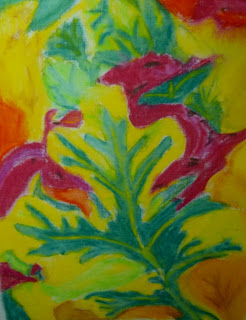I had a great time last week with 8 students in my Surface Design class at the Haliburton School of the Arts. We spent five days playing with Prismacolor Artist Pencils, Caran d'Ache Neocolor 2 Watersoluble Wax Pastels, Derwent Inktense Pencils, Shiva Paintstiks, Tsukineko Inks, and Foils. It was a very hands-on class in that I spent time talking about the properties of each product, ways one might use it, how to fix it, and then did a few demos. Students had the rest of the day to work.
Prismacolor Artist Pencils
Starting with a pale yellow fabric, Korleen shaded this tulip using Prismacolor Artist Pencils. I brought a selection of my reference photos for students to work with.
Caran d'Ache Neocolor 2 Water Soluble Wax Pastels
Sharon painted these oak leaves using wax pastels. The cool thing about these crayons is that when you brush on water you get a sort of watercolour effect.
If you only use a little bit of water on your brush, you blend your colours smoothly, as Cathy did with this orchid.
Karen's succulent (inspired by a photo I took in a botanical garden) makes great use of colour, and she then stitched around each pod.
Kathleen stitched this design on a quilt sandwich and then coloured in with wax pastels, which she brushed with a small amount of water to blend. It is based on one of my Tuscan sunflower photos.
Inktense Pencils
Lately I've been playing a bit with Inktense Pencils and decided to add them to this course. What I find particularly fun is stitching a free-hand design on a white quilt sandwich using black thread, to mimic the look of a pencil sketch, and then painting in the colour. When water is brushed on, the Inktense pencil work takes on a more intense and transparent look. The colour also seeps outside the stitched lines. Great for someone who is too rigid to colour outside the lines. In the sample below I've stitched the design and am just starting to add colour.
Below I've added my first layer of colour and used a wet brush.
A second go at the colour, and more wet brush, and I think it is almost finished.
Here's another rough thread sketch I did mimicing pencil lines. I think there might be some issues with the fence showing through the trees, but I'm pretty sure I can fix that. I did this one on silk dupioni and am just starting to add colour.
This one is just a thread doodle that I started to colour in.
Here is Nancy's thread doodle almost filled in with Inktense Pencils.
Helen stitched the industrial scene below with black thread, then added colour with Inktense pencils:
Shiva Paintstiks
We did some stencilling and basic landscape work with Shiva Paintstiks. Helen designed this cactus stencil.
Sharon created this coneflower stencil.
Tsukineko Inks
At the moment I am in love with Tsukineko inks and the potential for controlling colour depth with the use of aloe vera gel. The gel also acts as a smooth medium to spread the ink. I demonstrated on this peony design, based on one of my photos, and managed to finish it in class. After painting the peony on white cloth, I decided to fuse it to a more dramatic hand-dyed fabric.
I shared my peony design with students so they could learn how to use Tsukineko inks to control value. This is Korleen's peony.
It is hard to remember to take photos of everything. I know that Ila finished this piece, but my photo was taken after noticing what a great start she had and I forgot to take a photo of the finished piece.
Karen created this lake reflection design using the Tsukeniko Inkss
Cathy's marsh scene combines several methods, including hints of foil.
Foils
Students seemed most excited about the possibilities of using more than one foil colour in their designs. Korleen created this piece, which absolutely popped when she outline quilted it.
Kathleen's foiled leaf combines copper and red foil.
Ila combined several colours of foil on her leaf.
I've used and taught foils successfully for several years now, but in 2012 I have been experiencing some problems when using the foiling adhesive method. Students were having problems with silver and royal blue. Karen decided to run a test of all colours using both my newest adheisve as well as my oldest adhesive. We didn't come to any conclusions except that the silver is adhering in a blotchy fashion. I've reported it to the company I purchase it from and they have promised to run tests. I'll be running some tests of my own before I teach with foil again..
It's been a great summer so far (OK hot maybe) and I really enjoyed my time at Haliburton, both taking a class and teaching two. I'll be back teaching next year for three weeks: two weeks during the summer and one in October. When everything is confirmed I will provide more information. I get to stay home for a few weeks now and hope to spend some of it in the studio.















































